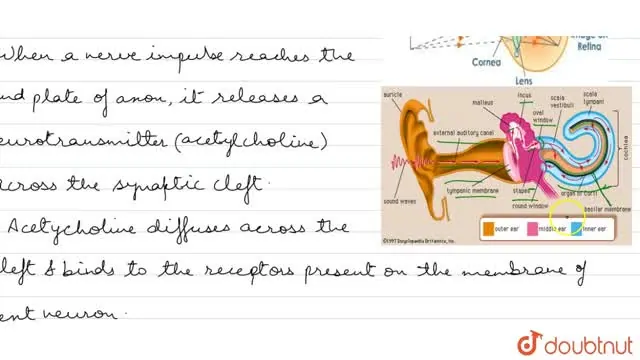Give a brief account of :
(a) Mechanism of synaptic transmission
(b) Mechanism of vision
(c) Mechanism of hearing
Video Solution
Text Solution
(a) Mechanism of synaptic transmission
Synapse is a junction between two neurons . It is present between the axon terminal of one neuron and the dendrite of next neuron separated by a cleft . There are two ways of synaptic transmission .
Chemical transmission : When a nerve impulse reaches the end plate of axon . it releases a neurotransmitter (acetycholine) across the synaptic cleft . The acetycholine diffuses across the cleft and binds to the receptors present on the membrane of next neuron. This causes depolarization of membrane and initiates an action potential .
Electrical transmission : an electric current is formed in the neuron . This electric current generates an action potential and leads to transmission of nerve impulses across the nerve fibre . This represents a faster method of nerve conduction than the chemical method of transmission.
(b) Mechanism of vision
Retina is the innermost layer of eye. It contians three layers of cells - inner ganglion cells, middle bipolar cells, and outermost photoreceptor cells. A photoreceptor cell is composed of a protein called opsin and changes, the permeability of membrane changeds, generating a potential difference in the cells. This generates an action potential in the ganglionic cells and is transmitted to the visual cortex of the brain via optic nerves. In the cortex region of brain, the impulses are analysed and image is formed on the retina.
(c) Mechansim of hearing
The pinna of the extranl region collects the sounds waves and directs it towards ear drum or ectrenal auditory canal. These waves strike the tympanic membrane and virbrations are created. Then, these vibrations are transmitted to the oval window, fenestore ovalis , thorught three ear ossicles, named as malleus, incus, and stapes. These ear ossicles act as lever and transmit the sound waves to internal ear. These vibrations from fenestra ovalis are transmitted into cochlear fluid. This generates sound waves in the lymph. The formation of waves generates a ripple in the basilar membrane.
As a result of this, sound waves are converted into nerve impulses. These impulses are then carried to auditory cortex of brain via auditory nerves. In cerebral cortex of brai, the impulses are analysed and sound is recognized.
|
Updated on:21/07/2023
Related Playlists
Similar Questions
NGP Mechanism
View SolutionMechanism Of Evolution
View SolutionReaction Mechanism
View SolutionReaction Mechanism
View SolutionReaction Mechanism
View SolutionReaction Mechanism
View SolutionReaction Mechanism
View SolutionReaction Mechanism
View SolutionReaction Mechanism
View SolutionReaction Mechanism
View Solution


